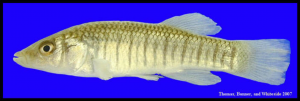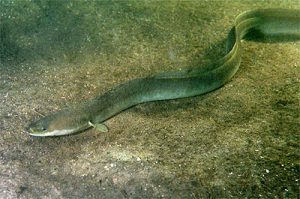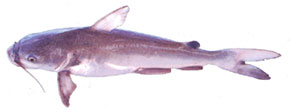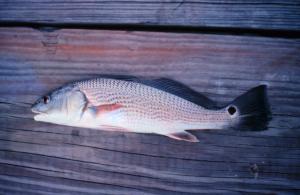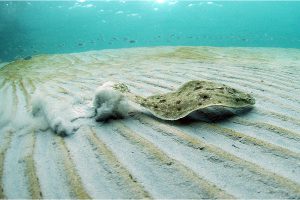We continue our series on estuarine and marine fish and wildlife with fish who live on the bottom.
The Gulf of Mexico is a huge ecosystem. With 600,000 m2 and an average depth of 6000 feet, there is a lot of “blue” out there for fish to find a home. But oddly enough, 69% of the species describe in the northern Gulf live on the bottom – what we call benthic fish.
This makes since really. In the “open blue” there are few places to hide from predators and prey. On the other hand, the seafloor has numerous places to hide – so there they are.
Most benthic fish have a general body design for living there. They are generally deep bodied, more rounded – as are their fins. They have a higher percentage of white muscle which makes them very explosive – for a few seconds. This is how they live. Blending in with the bottom, waiting for the prey to get within range and then exploding on it. This white muscle also gives these fish a distinctive taste, different from the red muscle typically found in the open water fish such as tuna.
In this environment, the sense of smell is very good. Many have taste and smell buds extended on fleshy appendages called barbels (the “whiskers” of a catfish). Many will have their mouth on the bottom side of their head for easier eating – though the predators (like the grouper) will still have it directly in front. Many will make short migrations into estuaries for breeding, but long open ocean migrations are not common. There are 342 species of benthic fish in the northern Gulf, let’s look at a few.
Eels
Something about these animals creeps us out. Maybe their similarity to snakes? Maybe the thought they are electric or venomous – neither of which are true. There are electric eels in the Amazon, but not in the ocean. They do behave much like snakes in that they have very sharp teeth for grabbing prey and can use them on fishermen if they need to. There are 16 species of eels in the northern Gulf. With the exception of the morays – eels live in sandy or muddy bottoms. Shrimpers frequently haul them up, and some are even known as shrimp eels. The American eel (Anguilla rostrata) has a cool life history. They spawn in the middle of the Atlantic Ocean, a place known to the sailors as the Sargasso Sea. It is in the middle of the vortex of ocean currents. The young that catch the northern currents and head to Europe – there they are known as the “European Eel”. Those that catch the southern swirl end up here in the United States are known as the “American Eel”. Their young look like thin pieces of plastic with eyes. Known as elvers they can be found within Pensacola Bay by the thousands when they arrive. The growing adults move up stream and spend part of their lives in our rivers and springs, before swimming back to the Atlantic and starting the process all over. In some areas, there is a commercial fishery for this eel.
Read more:
https://fws.gov/fisheries/freshwater-fish-of-america/american_eel.html.
https://www.fws.gov/fisheries/fishmigration/american_eel.html.
Catfish
This is a bottom fish that fishermen love to hate. Marine catfish (Ariopsis felis) are oily and not as popular as their freshwater cousins as food. So, when fishermen catch them, they tend to toss them on the beach to die – the idea is that there are fewer to breed – an idea that really does not work – they keep catching them. One interesting twist on this story is that the ghost crabs in the dunes drag the dead ones towards their burrows where they feed on them. The skull of the sea catfish is very hard – giving them their other common name “hardhead” catfish, or “steelhead”. When the crabs are finished the hard skull can be found and the bones on the belly (ventral) side resemble the cross. It is sold in some novelty stores as the “crucifix fish”. To add to the legend, when you shake it, it rattles. This has been described at the “soldiers rolling dice” at the crucifixion. They are actually loose bones. These “crucifix fish” are pretty neat, and pretty common.
The long “whiskers” (barbels) are for finding food buried beneath the sand or mud. It is also believed they may have a form of echolocation to detect prey. As if this were not interesting enough – the males carry the developing eggs within their mouths. Development takes about two weeks and young fish emerge from dad ready for the world.
One other thing the visitor should know – the serrated spine on the dorsal and the pectoral fins can inflict a nasty wound, even releasing a mild toxin. Most discover this when they step on a dead one tossed on the beach, or trying to get one off their hook – be careful of this.
Read more:
https://en.wikipedia.org/wiki/Hardhead_catfish.
http://gcrl.usm.edu/public/fish/hardhead.catfish.php.
https://www.floridamemory.com/items/show/269847.
Drum–Croaker
This is the largest family of estuarine fish in the northern Gulf of Mexico – with 18 species described. The whiting, drum, kingfish, croakers, trout, some perch, and others all belong to this group. They are popular with fishermen and seafood consumers. The red drum (redfish) is one of the more popular targets in our area. Speckled trout (or spotted seatrout) are also a favorite. Most have the characteristic body of a benthic fish. Deep bodied, rounded fins, mouth on the belly (ventral) side. Sea trout have two large “Dracula” looking fangs for grabbing shrimp and other prey. In most, one has broken off and the angler usually finds only one fang present. Some species, such as the black drum, will have short “whiskers” on their chins – you guessed it, barbels – and they are used for finding “buried treasure” (food).
Their common name drum (or croaker) comes from the sounds they produce using their swim bladders. Swim bladders are large sacs within many fish they can fill with gas and float off the bottom. The drum-croaker group rub this with internal muscles making resonating sounds that sound like they are “croaking”. Atlantic bottlenose dolphin can hear this too – and croakers make up a big part of their diet.
Read more:
http://gcrl.usm.edu/public/fish/red.drum.php.
http://gcrl.usm.edu/public/fish/spotted.seatrout.php.
http://gcrl.usm.edu/public/fish/southern.kingfish.php
http://gcrl.usm.edu/public/fish/sand.seatrout.php
Flounder
There are actually two types of flatfish in the Gulf – the flounder and the sole. How do you tell them apart?
Well, they are born as a typical-normal looking fish, but as they grow one eye begins to “slide” across the top of the head to the other side – both eyes are now on one side of the head – weird right?
In our part of the Gulf, if the eyes slide to the left side – we call it a flounder, to the right – a sole. There are a FEW exceptions to this rule – but many call the popular flounder the “left-eyed flounder” as opposed to the “right-eyed” one.
So why do they do this?
If your eyes were placed on each side of a torpedo pointed head, you would have what we call monocular vision. This type of vision gives you ALMOST 360° range of view… almost. So even though you can see what is behind you while facing forward, you do not have good depth perception – so you are not sure exactly how far away it is. You must either rely on other senses to help you out or get lucky. Having both eyes on one side (or in front like us) you have binocular vision. You cannot see behind you, but you can tell the distance of the object in front of you. This is common for predator fish like flounder. Many would agree that your mother has both!
With the eyes on one side of the head, they lose color on the other and then lay flat on one side. They can bury in sand and wait for prey. Most species have chromatophores in their skin. These are cells that allow them to change color, like a chameleon or octopus. So, they can change their color to blend into whatever bottom type they are on. What an incredible adaptation.
There are 17 species of flounder, and they are not easy to tell apart – so just call them flounder.
Read more:
http://gcrl.usm.edu/public/fish/flounder.php.
- Our Environment: Part 11 – We Need Water - July 7, 2025
- Our Environment: Part 10 – Improving Agriculture - June 20, 2025
- Marine Creatures of the Northern Gulf – Snails and Slugs - June 20, 2025

